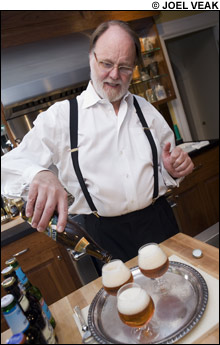Forget Munich. A local German beer expert offers a primer on the best Bavarian lagers to enjoy this Oktoberfest — and all autumn long.
Ten other German (and German-style) beers you should try this fall
The Kaiser Imperial Oktoberfest
Harpoon Kellerbier
Warsteiner Premium Dunkel
Carlsberg Jacobsen Dark Lager
Aventinus Weizenbock
Paulaner Salvator
Boston Beer Works Kenmore Kölsch
Aecht Schlenkerla Rauchbier Märzen
Spaten Optimator
Uerige Doppelsticke
|
To hear it told, Munich’s Oktoberfest these days is a circus. A boorish, borborygmic bacchanal, overflowing with trashed tourists and flatulent tubas. It’s become, says Horst Dornbusch — a German ex-pat and brewing expert who lives on the North Shore — a kitschy moneymaking machine: “a vulgar spectacle for the burping and farting set.”
Authentic? Nein. “The traditional Bavarian music has been replaced by a lot of rhythm and blues, rock and roll,” says Dornbusch. “Bavarians in their lederhosen playing New Orleans jazz.”
Oh, the locals will stop in at the fairgrounds at least once, for tradition’s sake, to quaff a stein — or three. But they’ll usually do so early in the day, “while the visitors sleep off their hangover. And by about three o’clock in the afternoon, they clear out. That’s when the world shows up.”
As such, even though Dornbusch — who’s from Dusseldorf and emigrated here by boat in 1969 — still returns to Germany three to five times a year as part of his brewery consulting business, “during Oktoberfest, you will never find me in Munich.”
You will, however, find him in his West Newbury kitchen, dressed in an open-collared tuxedo shirt, holding a goblet of glowing golden German lager to the light and expounding with rhapsodic erudition on the exacting art and science of Bavarian brewing.
Indeed, that sloppy, sloshy fortnight of Deutsch debauchery — the fest started this past Saturday and lasts until October 7 — stands in stark contrast with the meticulous, precise method behind the crafting of Munich’s full-bodied, malt-heavy, lightly hopped Oktoberfest beers.
As the air chills and the leaves turn, the beginning of autumn marks the beer enthusiast’s favorite time of year, when the brews get darker and stronger, their flavors more complex. And so, as nearly seven million tourists throng München this week — many guzzling to oblivion, slumping over as bloated bierleichen (“beer corpses”) on the tents’ long tables without a thought in the world for the nuances of beers’ color or flavor — the Phoenix figured it could save you mega-marks in travel fees — not to mention dry cleaning — by keeping you in the Bay State this Oktober. Dornbusch was all too happy to oblige us with a marathon four-hour tasting session while expounding on the finer points of Bavarian lager.
Summertime blues
The first Oktoberfest was on October 12, 1810, a massive gathering of 40,000 people thrown in a meadow outside Munich by Crown Prince Ludwig of Bavaria to commemorate his marriage to Therese of Saxe-Hildburghausen. But if Oktoberfest kicked off officially nearly two centuries ago, the roots of Oktoberfest beer actually date back much further than that.
Sometime in the 1550s, Albrecht V, duke of Bavaria, issued a ban on brewing in the summer. The reason? Beer tasted awful then. In those pre-pasteurization days, no one understood that it was caused by teeming bacteria. “In the winter, the beer tasted great,” says Dornbusch. “In the summer, it tasted horrible: medicinal, sour, skunky. They didn’t know why, but they knew that. The response was to outlaw it.”
But thirsty Germans cannot last a summer without beer. Unthinkable. The answer, then, was to work overtime in March and April, making barrels and barrels of stronger, slightly hoppier beer, then caching them away in cellars or mountain caves to keep them cool. This lager, called Märzen (“March”), was dipped into over the course of the summer until brewing could legally begin anew in September.
In those days, cooperage was very expensive — barrels were precious commodities. So to free up the casks for the new batches of fall beer, folks would gather around harvest time for an informal celebration to finish off the Märzen beer, at this point mellowed and clarified by its cool summer-long rest, in October.
The designation “Märzen Oktoberfestbier” is not a calendar-jumbling contradiction in terms. It simply means a Märzen beer that, keeping with tradition, is consumed in October.

THE HUNT FOR PERFECT OKTOBER: German brewing expert Horst Dornbusch gives us the best four-hour lesson of our lives.
|
As Dornbusch defines it, a “Märzen” is a pale but full-bodied lager brewed with Munich malt and aromatic German hops — Hallertauer, say, or Tettnanger — with an alcohol by volume between five and six percent. A Märzen-Oktoberfestbier is a Märzen that has been aged for at least two months but not longer than six. Got it? Gut.
When discussing German beer, one soon understands that definitions and rules are inherent in the style. And not just the famed Reinheitsgebot (or “Purity Law”) that was on the books from 1516 until 1987 — “the only ingredients used for the brewing of beer must be Barley, Hops, and Water. Whosoever knowingly disregards or transgresses upon this ordinance, shall be punished” — and is still followed voluntarily by most brewers.